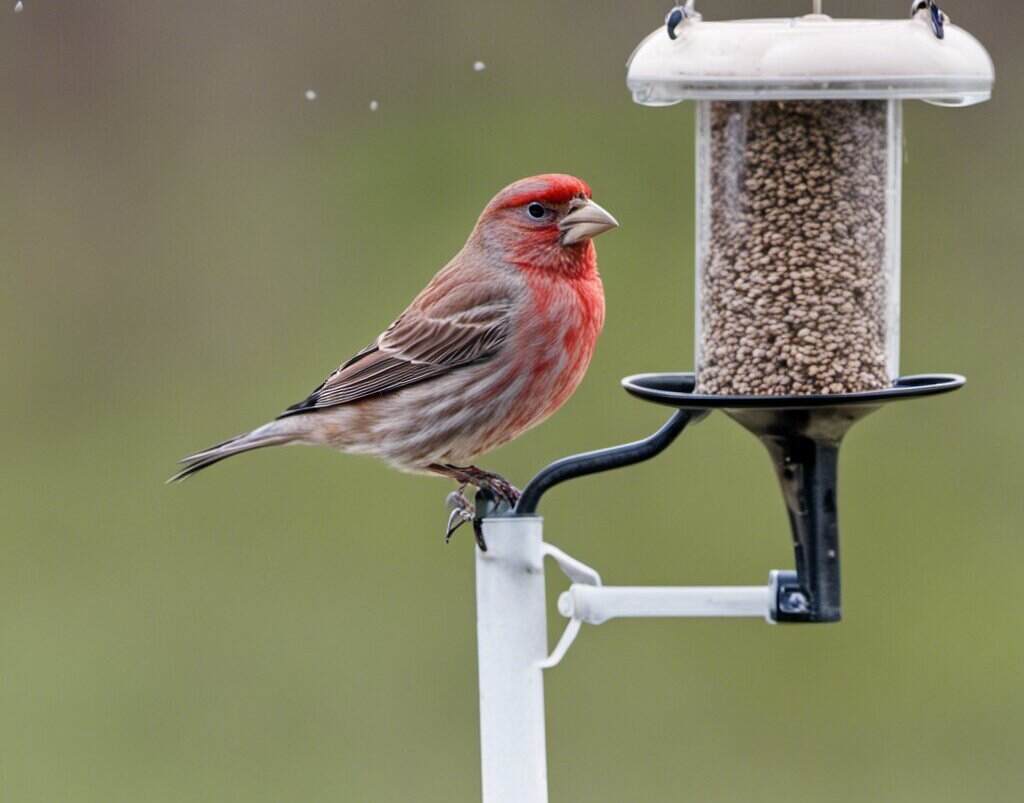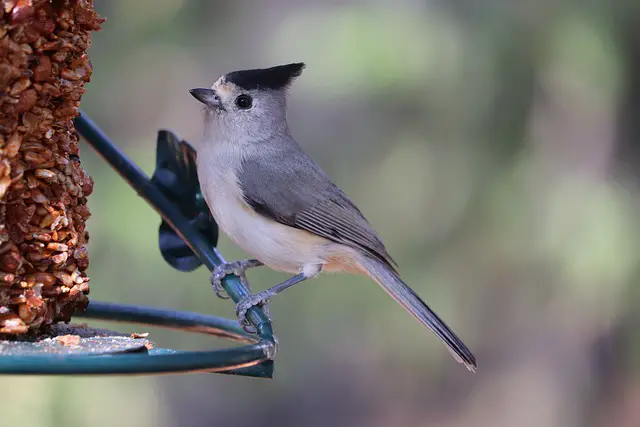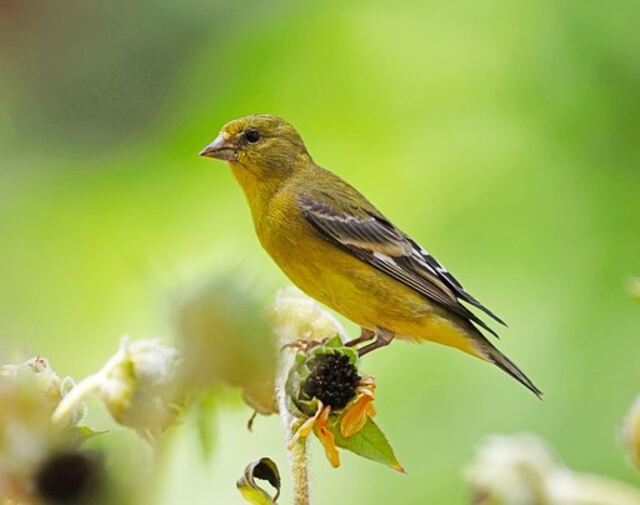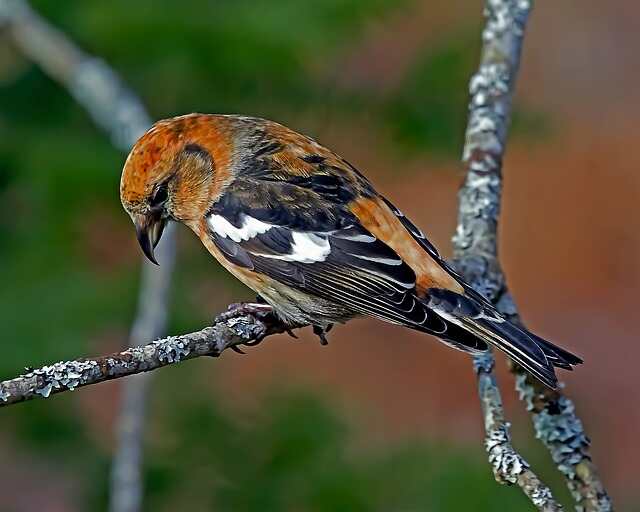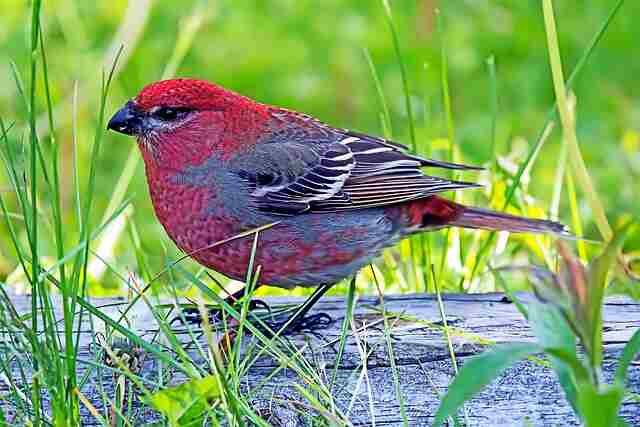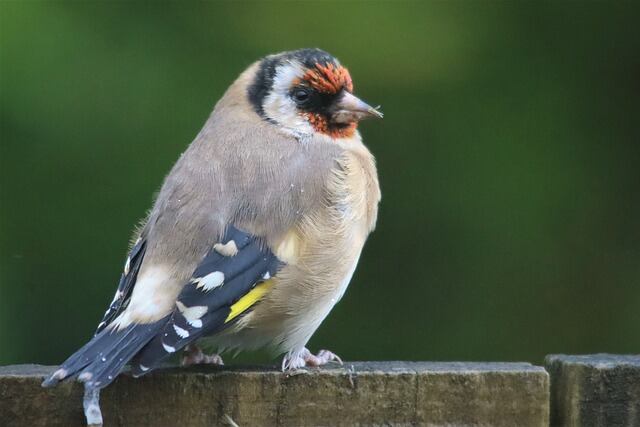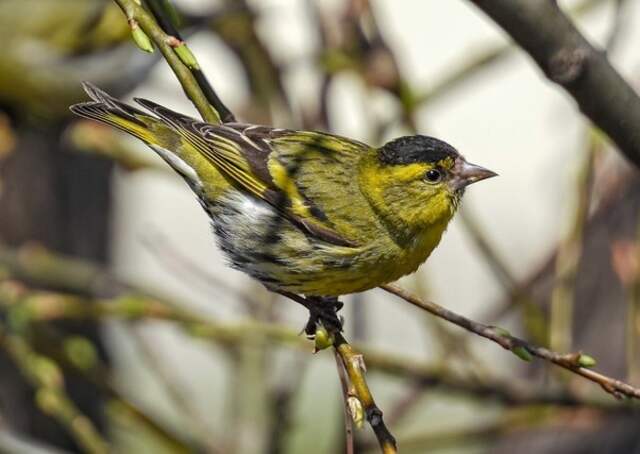Welcome to the world of bird feeding! If you’re curious about which birds enjoy niger seed, you’ve come to the right place. In this guide, we’ll explore the avian species that are attracted to this tiny, nutrient-rich seed, providing valuable insights into the fascinating world of backyard birdwatching.
Table of Contents
- 1 About Niger Seeds
- 2 Birds That Love to Eat Niger Seed
- 2.1 House Finch
- 2.2 Indigo Bunting
- 2.3 American Goldfinch
- 2.4 Purple Finch
- 2.5 Pine Siskin
- 2.6 House Sparrow
- 2.7 Tufted Titmouse
- 2.8 Lesser Goldfinch
- 2.9 Pine Siskin
- 2.10 Common Redpoll
- 2.11 White-winged Crossbill
- 2.12 Pine Grosbeak
- 2.13 European Goldfinch
- 2.14 American Tree Sparrow
- 2.15 Dark-eyed Junco
- 2.16 Song Sparrow
- 2.17 Chipping Sparrow
- 2.18 White-crowned Sparrow
- 2.19 Eurasian Siskin
- 2.20 Black-capped Chickadee
- 3 Attracting Birds with Nyjer Seed
- 4 Bird Feeder Options for Nyjer Seed
- 5 Author
About Niger Seeds
Niger also known as Nyjer is a highly nutritious and popular type of birdseed that is often used to attract finches and other small birds to backyard feeders. Despite its nickname as “thistle seed,” Niger is actually derived from the African yellow daisy plant. This small, thin, black seed is high in oil, making it a great source of energy for birds.
While Niger is a popular choice among backyard birders, it can also be one of the most expensive types of birdseed due to import prices and retailer options. To make the most of their investment, many birders choose to offer Niger in specialized feeders that prevent accidental spills and waste.
Niger is often found in finch mix or canary birdseed blends, which also include sunflower chips or small millet seeds that appeal to birds that eat Niger. These blends are often less expensive than pure thistle seed and can be a great option for birders looking to attract a variety of small birds to their feeders.
| Niger Seed Benefits | Description |
|---|---|
| High Protein Content | Rich source of protein, essential for growth and repair of tissues. |
| Healthy Fats | Contains heart-healthy fats, including Omega-3 fatty acids. |
| Rich in Fiber | Provides dietary fiber, aiding digestion and promoting fullness. |
| Nutrient Dense | Packed with essential minerals like calcium, iron, and magnesium. |
| Antioxidant Properties | Contains antioxidants that help combat free radicals in the body. |
| Weight Management | High protein and fiber content can assist in weight control. |
| Cardiovascular Health | Omega-3s may support heart health and lower cholesterol levels. |
| Bone Health | Good source of calcium and phosphorus for strong bones. |
| Anti-Inflammatory | May help reduce inflammation due to its Omega-3 fatty acids. |
| Immune Support | Nutrient profile supports overall immune system function. |
Birds That Love to Eat Niger Seed
House Finch
(Haemorhous mexicanus)
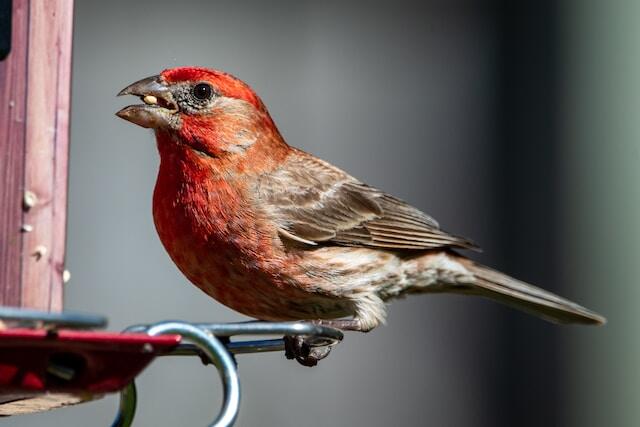
| Attribute | Measurement |
|---|---|
| Length | Approximately 5 – 6 inches (13-15 cm) |
| Weight | About 0.6 – 1.1 ounces (16-31 grams) |
| Wingspan | Approximately 7.5 – 8.5 inches (19-22 cm) |
| Diet | Seeds, fruits, insects, particularly niger (thistle) seeds |
| Habitat | Urban and suburban areas, towns, rural areas |
| Range | Originally native to western North America, now found across the continent |
- Urban Companion: The House Finch is a familiar and adaptable bird, often found in urban and suburban areas.
- Habitat: House Finches are highly adaptable and can be found in various environments, including cities, towns, and rural areas.
- Dietary Preferences: They have a varied diet that includes seeds, fruits, and insects. They are particularly fond of niger (thistle) seeds.
- Distinctive Appearance: Recognizable by their brown streaked plumage, males have red plumage on their heads, throats, and chests, while females have more subdued coloring.
- Vocal and Gregarious: House Finches are known for their cheerful songs and their tendency to gather in flocks, especially around bird feeders.
- Nesting Habits: They often nest in a variety of locations, including ledges, trees, and even hanging planters, creating cup-shaped nests made of twigs and fibers.
- Inviting to Bird Feeders: House Finches are frequent visitors to bird feeders, especially when offering niger seeds, sunflower seeds, and other small seeds.
- Range: House Finches are native to western North America but have expanded their range across the continent due to human habitation.
Indigo Bunting
(Passerina cyanea)
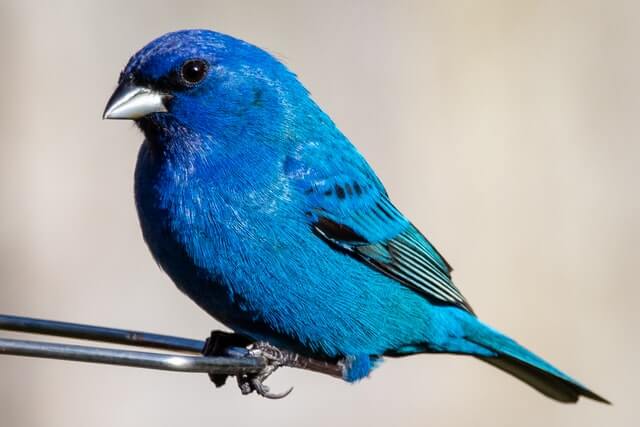
| Attribute | Measurement |
|---|---|
| Length | Approximately 5.5 – 6 inches (14-15 cm) |
| Weight | About 0.4 – 0.6 ounces (11-17 grams) |
| Wingspan | Approximately 7.5 – 8.5 inches (19-22 cm) |
| Diet | Seeds (including niger seeds), insects |
| Habitat | Open fields, woodlands, shrubby areas, forest edges |
| Range | Breeds in eastern and central North America, migrates to Central America and northern South America for winter |
- Vivid Songster: The Indigo Bunting is a vividly colored songbird celebrated for its striking appearance and melodious songs.
- Breeding Grounds: Found primarily in eastern and central North America during the breeding season.
- Winter Retreat: Migrates to Central America and northern South America during the winter months, seeking warmer climates.
- Summer Delight: During the summer, you’ll have the chance to spot Indigo Buntings in a variety of habitats, including open fields, woodlands, and along roadsides.
- Dietary Preferences: This bunting primarily feeds on seeds, including niger seeds, as well as insects, making it a versatile feeder visitor.
- Habitat: Indigo Buntings are often found in a range of habitats, from open fields to shrubby areas and forest edges.
- Distinctive Plumage: Males are known for their brilliant indigo-blue plumage, while females have more subdued coloring.
- Songbird Serenade: The Indigo Bunting’s melodious song is a delight to bird enthusiasts, filling its habitat with beautiful music.
- Range: Indigo Buntings are native to eastern and central North America, breeding from southern Canada to the southern United States.
American Goldfinch
(Spinus tristis)
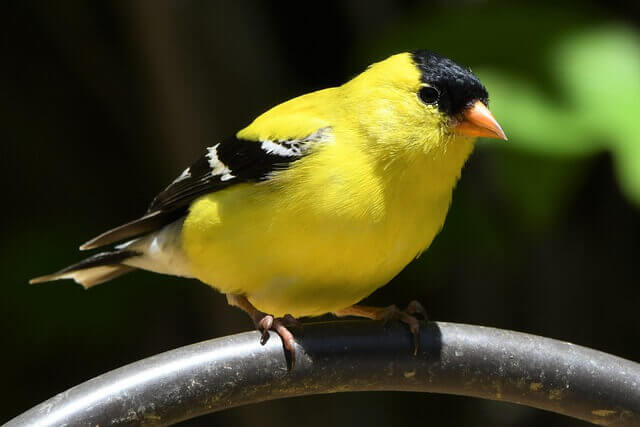
| Attribute | Measurement |
|---|---|
| Length | Approximately 4.5 – 5 inches (11-13 cm) |
| Weight | About 0.4 – 0.7 ounces (11-20 grams) |
| Wingspan | Approximately 7.5 – 8.5 inches (19-22 cm) |
| Diet | Seeds, particularly niger (thistle) seeds, sunflower seeds, and other small seeds |
| Habitat | Open habitats, fields, meadows, gardens, weedy areas |
| Range | North America, from southern Canada to the southern United States |
- Sunny Visitor: The American Goldfinch, often called the “Wild Canary,” is a bright and cheerful bird known for its vibrant yellow plumage.
- Habitat: American Goldfinches are commonly found in open habitats, including fields, meadows, and gardens, often with a preference for weedy areas.
- Dietary Preferences: They primarily feed on seeds, including niger (thistle) seeds, sunflower seeds, and other small seeds. They are particularly fond of niger seeds.
- Distinctive Appearance: Recognizable by their bright yellow plumage during the breeding season, with males being the most colorful. In winter, they have more subdued olive-brown plumage.
- Vocal and Sociable: American Goldfinches are known for their musical calls and their tendency to gather in flocks, especially around bird feeders.
- Nesting Habits: They often nest in trees and shrubs, creating cup-shaped nests made of plant fibers and down.
- Inviting to Bird Feeders: American Goldfinches are frequent visitors to bird feeders, especially when offering niger seeds, sunflower seeds, and other small seeds.
- Range: American Goldfinches are native to North America and have a wide range that spans from southern Canada to the southern United States.
Purple Finch
(Haemorhous purpureus)
| Attribute | Measurement |
|---|---|
| Length | Approximately 6 – 7 inches (15-18 cm) |
| Weight | About 1 – 1.3 ounces (28-37 grams) |
| Wingspan | Approximately 9 – 10 inches (23-25 cm) |
| Diet | Seeds, fruits, insects, particularly niger (thistle) seeds |
| Habitat | Coniferous and mixed forests, wooded areas |
| Range | North America, from Canada to the eastern United States |
- Woodland Gem: The Purple Finch is a charming songbird known for its melodious tunes and vibrant plumage.
- Habitat: Purple Finches are commonly found in various wooded habitats, including coniferous and mixed forests.
- Dietary Preferences: They primarily feed on seeds, fruits, and insects. They have a preference for niger (thistle) seeds, sunflower seeds, and fruits.
- Distinctive Appearance: Recognizable by their raspberry-red plumage in males, while females have brown streaked plumage.
- Vocal and Musical: Purple Finches are known for their melodious songs, adding a musical touch to their woodland homes.
- Nesting Habits: They often build nests in trees or shrubs, creating cup-shaped nests made of twigs, grasses, and feathers.
- Inviting to Bird Feeders: Purple Finches are frequent visitors to bird feeders, especially when offering niger seeds, sunflower seeds, and other small seeds.
- Range: Purple Finches are native to North America, with a range extending from Canada to the eastern United States.
Pine Siskin
(Spinus pinus)
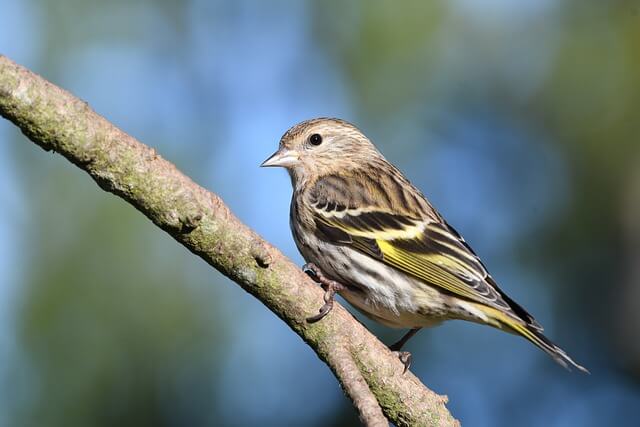
| Attribute | Measurement |
|---|---|
| Length | Approximately 4.5 – 5.5 inches (11-14 cm) |
| Weight | About 0.4 – 0.7 ounces (11-20 grams) |
| Wingspan | Approximately 7 – 9 inches (18-23 cm) |
| Diet | Seeds, including conifer seeds, sunflower seeds, niger (thistle) seeds |
| Habitat | Coniferous forests, woodlands, various habitats during migrations |
| Range | Native to North America, migratory with a range extending from Alaska to the southern United States |
- Northern Nomad: The Pine Siskin is a small, nomadic bird known for its irruptive migrations in search of food.
- Habitat: Pine Siskins are often found in coniferous forests and woodlands, but they can appear in a variety of habitats during migrations.
- Dietary Preferences: Their diet primarily consists of seeds, including conifer seeds, sunflower seeds, and niger (thistle) seeds.
- Distinctive Appearance: Recognizable by their streaked brown plumage with hints of yellow on their wings and tails.
- Vocal and Sociable: Pine Siskins are known for their high-pitched, twittering calls and their tendency to forage in flocks, especially around feeding stations.
- Nesting Habits: They build nests in conifer trees, creating cup-shaped nests made of twigs, grasses, and feathers.
- Inviting to Bird Feeders: Pine Siskins are frequent visitors to bird feeders, particularly when offering niger seeds, sunflower seeds, and other small seeds.
- Range: Pine Siskins are native to North America, with a range extending from Alaska to the southern United States, but they are highly migratory and can appear outside their usual range.
House Sparrow
(Passer domesticus)

| Attribute | Measurement |
|---|---|
| Length | Approximately 5.5 – 6.5 inches (14-16.5 cm) |
| Weight | About 0.7 – 1.0 ounces (20-30 grams) |
| Wingspan | Approximately 7.5 – 9 inches (19-23 cm) |
| Diet | Seeds, grains, insects, human-provided food scraps, including niger (thistle) seeds |
| Habitat | Urban and suburban areas, towns, agricultural areas |
| Range | Widely distributed across Europe, Asia, North America, and other regions due to human habitation |
- Urban Companion: The House Sparrow is a small, common bird often seen in urban and suburban areas worldwide.
- Habitat: House Sparrows are highly adaptable and can be found in various environments, including cities, towns, and agricultural areas.
- Dietary Preferences: They have a diverse diet that includes seeds, grains, insects, and human-provided food scraps. They readily consume niger (thistle) seeds.
- Distinctive Appearance: Recognizable by their brownish-gray plumage, males have black throats and chestnut napes, while females have more subdued coloring.
- Vocal and Social: House Sparrows are known for their chirping calls and their gregarious nature, often gathering in noisy flocks.
- Nesting Habits: They often nest in a variety of locations, including buildings, trees, and nest boxes, creating cup-shaped nests made of grass, twigs, and feathers.
- Inviting to Bird Feeders: House Sparrows are frequent visitors to bird feeders, especially when offering niger seeds, sunflower seeds, and other small seeds.
- Range: House Sparrows have a wide distribution and are found across Europe, Asia, North America, and other regions due to human habitation.
Tufted Titmouse
(Baeolophus bicolor)
| Attribute | Measurement |
|---|---|
| Length | Approximately 6 – 6.5 inches (15-17 cm) |
| Weight | About 0.6 – 1 ounce (18-28 grams) |
| Wingspan | Approximately 7.5 – 10 inches (19-25 cm) |
| Diet | Insects, seeds, berries, nuts |
| Habitat | Deciduous and mixed forests |
| Range | Eastern North America, from the Great Plains to the Atlantic Coast |
- Forest Companion: The Tufted Titmouse is a charming and acrobatic bird often found in woodlands and forests.
- Habitat: Tufted Titmice are commonly found in deciduous and mixed forests across eastern North America.
- Dietary Preferences: Their diet primarily consists of insects, seeds, berries, and nuts. They are skilled foragers known for their agile feeding habits.
- Distinctive Appearance: Recognizable by their gray plumage, crested heads, and their prominent dark eyes and black markings around the eyes.
- Vocal and Active: Tufted Titmice are known for their clear, whistled calls and their energetic behavior as they flit among branches and foliage.
- Nesting Habits: They often build nests in tree cavities, nest boxes, and sometimes abandoned woodpecker holes, creating cup-shaped nests made of leaves, grasses, and fur.
- Inviting to Bird Feeders: Tufted Titmice are frequent visitors to bird feeders, particularly when offering sunflower seeds, suet, and nuts.
- Range: Tufted Titmice are native to eastern North America, with a range extending from the Great Plains to the Atlantic Coast.
Lesser Goldfinch
(Spinus psaltria)
- Colorful Gem: The Lesser Goldfinch is a small and vibrant songbird known for its striking yellow plumage.
- Habitat: Lesser Goldfinches are commonly found in a variety of open habitats, including grasslands, shrubby areas, and gardens.
- Dietary Preferences: Their diet primarily consists of seeds, especially niger (thistle) seeds, as well as dandelion seeds, sunflower seeds, and insects.
- Distinctive Appearance: Recognizable by their bright yellow plumage, with males having black caps on their heads and a black back, while females have more subdued coloring.
- Vocal and Musical: Lesser Goldfinches are known for their cheerful songs and melodic calls, which add a delightful soundtrack to their habitat.
- Nesting Habits: They often build nests in shrubs or trees, creating cup-shaped nests made of plant fibers, grasses, and feathers.
- Inviting to Bird Feeders: Lesser Goldfinches are frequent visitors to bird feeders, especially when offering niger seeds and sunflower seeds.
- Range: Lesser Goldfinches are native to western North America, from the western United States to Central America.
| Attribute | Measurement |
|---|---|
| Length | Approximately 4 – 4.5 inches (10-11 cm) |
| Weight | About 0.3 – 0.4 ounces (9-12 grams) |
| Wingspan | Approximately 7 – 8 inches (18-20 cm) |
| Diet | Seeds, especially niger (thistle) seeds, dandelion seeds, sunflower seeds, and insects |
| Habitat | Grasslands, shrubby areas, gardens |
| Range | Western North America, from the western United States to Central America |
Pine Siskin
(Spinus pinus)
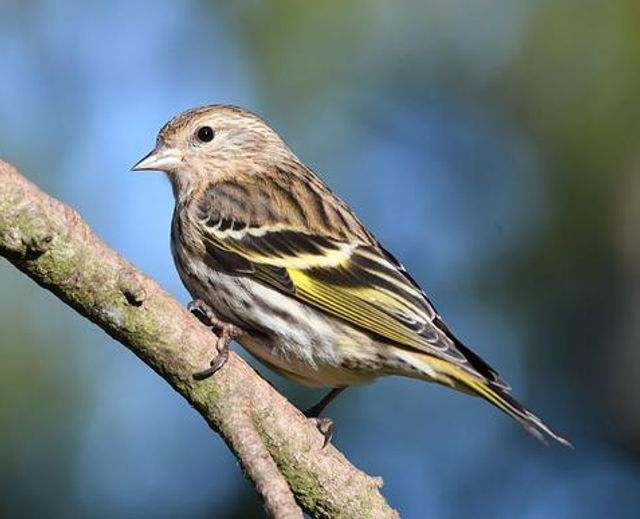
| Attribute | Measurement |
|---|---|
| Length | Approximately 4.5 – 5.5 inches (11-14 cm) |
| Weight | About 0.4 – 0.6 ounces (12-17 grams) |
| Wingspan | Approximately 7 – 9 inches (18-23 cm) |
| Diet | Seeds, particularly niger (thistle) seeds, tree seeds, buds, insects |
| Habitat | Coniferous forests, woodlands, backyards |
| Range | Highly nomadic, covering North America from coast to coast, with variations due to irruptions |
- Tiny Seed Lover: The Pine Siskin is a small, nomadic bird known for its love of seeds, particularly niger (thistle) seeds.
- Habitat: Pine Siskins are often found in various habitats, including coniferous forests, woodlands, and backyards.
- Dietary Preferences: Their diet primarily consists of seeds, especially niger seeds, as well as tree seeds, buds, and insects.
- Distinctive Appearance: Recognizable by their streaked brown plumage and a subtle touch of yellow on their wings and tails.
- Vocal and Sociable: Pine Siskins are known for their twittering calls and their tendency to forage in flocks, often mixing with other finch species.
- Nesting Habits: They often build nests in conifer trees, creating cup-shaped nests made of grasses, moss, and feathers.
- Inviting to Niger Seed Feeders: Pine Siskins are frequent visitors to bird feeders, especially when offering niger seeds, sunflower seeds, and other small seeds.
- Range: Pine Siskins are highly nomadic, and their range can vary widely, covering North America from coast to coast and sometimes reaching the southern United States during irruption years.
Common Redpoll
(Acanthis flammea)

| Attribute | Measurement |
|---|---|
| Length | Approximately 4.5 – 5.5 inches (11-14 cm) |
| Weight | About 0.4 – 0.9 ounces (11-26 grams) |
| Wingspan | Approximately 7.5 – 9 inches (19-23 cm) |
| Diet | Seeds, especially birch and alder seeds, niger (thistle) seeds at feeders |
| Habitat | Boreal forests, tundra, shrubby areas |
| Range | Arctic regions of North America and Eurasia, with some winter migrations to more southern latitudes |
- Arctic Visitor: The Common Redpoll is a small, Arctic-breeding bird known for its hardiness and distinctive plumage.
- Habitat: Common Redpolls are typically found in northern boreal forests and tundra habitats, particularly during the winter months.
- Dietary Preferences: Their diet primarily consists of seeds, especially those of birch and alder trees. They have a particular fondness for niger (thistle) seeds at bird feeders.
- Distinctive Appearance: Recognizable by their small size, streaked brown plumage, and a bright red cap on their heads.
- Vocal and Social: Common Redpolls are known for their twittering calls and their tendency to forage in small flocks.
- Nesting Habits: They often build nests in shrubs or trees, creating cup-shaped nests made of twigs, grasses, and feathers.
- Inviting to Bird Feeders: Common Redpolls are frequent visitors to bird feeders, especially when offering niger seeds, sunflower seeds, and other small seeds.
- Range: Common Redpolls are native to the Arctic regions of North America and Eurasia, with some winter migrations to more southern latitudes.
White-winged Crossbill
(Loxia leucoptera)
| Attribute | Measurement |
|---|---|
| Length | Approximately 6 – 7 inches (15-18 cm) |
| Weight | About 1 – 1.5 ounces (28-43 grams) |
| Wingspan | Approximately 10 – 11 inches (25-28 cm) |
| Diet | Conifer seeds, especially spruce and pine seeds |
| Habitat | Coniferous forests |
| Range | North America, with a range across northern and western regions |
- Specialized Feeder: The White-winged Crossbill is a unique bird known for its distinctive crossed bill and specialized feeding habits.
- Habitat: White-winged Crossbills are often found in coniferous forests across North America.
- Dietary Preferences: Their diet primarily consists of conifer seeds, especially those of spruce and pine trees. Their crossed bills help them extract seeds from cones.
- Distinctive Appearance: Recognizable by their deep red plumage in males, with white wingbars and crossed bills, while females are more subdued in coloring.
- Vocal and Nomadic: White-winged Crossbills are known for their soft calls and nomadic behavior, often moving in search of abundant cone crops.
- Nesting Habits: They build nests in conifer trees, creating cup-shaped nests made of twigs and bark strips.
- Inviting to Pine Forests: White-winged Crossbills are best observed in coniferous forests where they forage for seeds in the cones of pine and spruce trees.
- Range: White-winged Crossbills are native to North America, with a range extending across northern and western regions.
Pine Grosbeak
(Pinicola enucleator)
| Attribute | Measurement |
|---|---|
| Length | Approximately 7.5 – 9 inches (19-23 cm) |
| Weight | About 1.5 – 2.5 ounces (42-71 grams) |
| Wingspan | Approximately 12 – 13 inches (30-33 cm) |
| Diet | Seeds, berries, tree buds, particularly conifer seeds |
| Habitat | Northern coniferous forests, sometimes migrating south in search of food |
| Range | Northern regions of North America, including Alaska, Canada, and parts of the northern United States |
- Northern Gem: The Pine Grosbeak is a beautiful and robust bird known for its striking appearance and northern habitat.
- Habitat: Pine Grosbeaks are typically found in northern coniferous forests, particularly during the winter when they may venture south in search of food.
- Dietary Preferences: Their diet primarily consists of seeds, berries, and tree buds. They are especially fond of the seeds of conifer trees.
- Distinctive Appearance: Recognizable by their deep red plumage, males have a bright rosy-red coloring, while females and juveniles have more subdued plumage.
- Vocal and Migratory: Pine Grosbeaks are known for their melodious calls, and their migration patterns are influenced by the availability of food.
- Nesting Habits: They often build nests in conifer trees, creating cup-shaped nests made of twigs, grasses, and moss.
- Inviting to Sight: Pine Grosbeaks are best observed in northern coniferous forests during the winter months when they forage for food.
- Range: Pine Grosbeaks are native to northern regions of North America, including Alaska, Canada, and parts of the northern United States.
European Goldfinch
(Carduelis carduelis)
| Attribute | Measurement |
|---|---|
| Length | Approximately 4.7 – 5.5 inches (12-14 cm) |
| Weight | About 0.6 – 0.7 ounces (17-20 grams) |
| Wingspan | Approximately 7.5 – 8.7 inches (19-22 cm) |
| Diet | Seeds, particularly niger (thistle) seeds, small insects during breeding season |
| Habitat | Gardens, woodlands, open countryside |
| Range | Native to Europe, western Asia, parts of North Africa, with expanding populations |
- Colorful Charmer: The European Goldfinch is a colorful and charming bird known for its striking plumage and delightful song.
- Habitat: European Goldfinches are commonly found in various habitats, including gardens, woodlands, and open countryside across Europe and parts of Asia and North Africa.
- Dietary Preferences: Their diet primarily consists of seeds, particularly niger (thistle) seeds, as well as small insects during the breeding season.
- Distinctive Appearance: Recognizable by their vibrant red faces, black and white markings on their wings, and golden-yellow plumage.
- Vocal and Melodic: European Goldfinches are known for their melodious songs and tinkling calls, which add a musical touch to their environment.
- Nesting Habits: They often build nests in trees and shrubs, creating cup-shaped nests made of fine twigs, grasses, and feathers.
- Inviting to Niger Seeds: European Goldfinches are avid consumers of niger seeds, making them a common visitor to feeders with niger seed offerings.
- Range: European Goldfinches are native to Europe, western Asia, and parts of North Africa, with populations expanding in some regions.
American Tree Sparrow
(Spizelloides arborea)
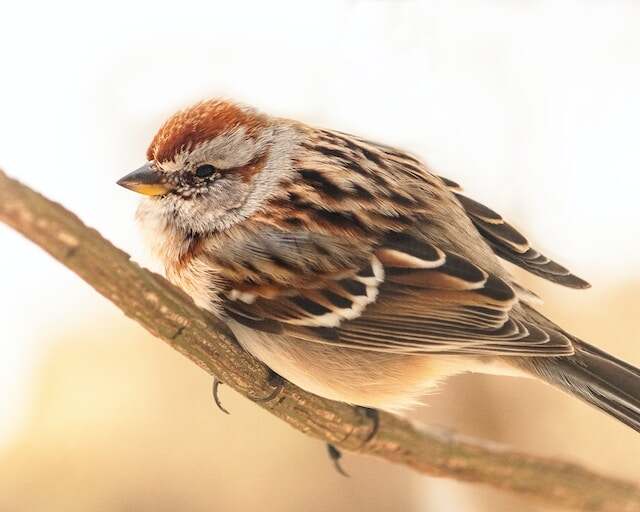
| Attribute | Measurement |
|---|---|
| Length | Approximately 5.5 – 6 inches (14-15 cm) |
| Weight | About 0.6 – 0.9 ounces (17-26 grams) |
| Wingspan | Approximately 7.5 – 9 inches (19-23 cm) |
| Diet | Seeds (including niger seeds), grass seeds, berries, insects |
| Habitat | Open habitats, fields, gardens, suburban areas |
| Range | Breeds in the Arctic regions of North America, winters in the northern United States and southern Canada |
- Winter Visitor: The American Tree Sparrow is a charming songbird known for its winter visits to North America.
- Habitat: During the winter months, American Tree Sparrows can be found in open habitats, including fields, gardens, and suburban areas across North America.
- Dietary Preferences: Their diet primarily consists of seeds, including niger (thistle) seeds, grass seeds, and berries, with occasional insects.
- Distinctive Appearance: Recognizable by their rusty cap and eyeline, gray face, and brown streaked plumage with a central breast spot.
- Vocal and Unobtrusive: American Tree Sparrows have a soft, musical song and are typically inconspicuous birds during their winter stay.
- Nesting Habits: They breed in the far northern regions of North America during the summer, constructing nests of grasses and feathers.
- Inviting to Feeders: American Tree Sparrows are occasional visitors to bird feeders, especially when offering niger seeds, millet, and sunflower seeds.
- Range: American Tree Sparrows breed in the Arctic regions of North America and migrate south to winter across the northern United States and southern Canada.
Dark-eyed Junco
(Junco hyemalis)
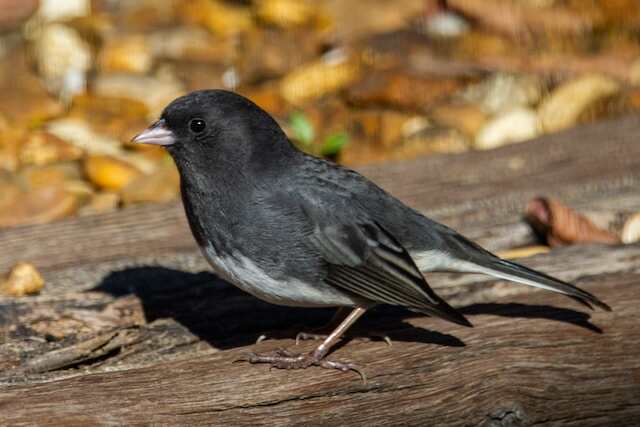
| Attribute | Measurement |
|---|---|
| Length | Approximately 5 – 6 inches (13-15 cm) |
| Weight | About 0.6 – 1.1 ounces (16-31 grams) |
| Wingspan | Approximately 7.5 – 9.5 inches (19-24 cm) |
| Diet | Seeds (millet, sunflower, niger), insects |
| Habitat | Forests, parks, residential areas |
| Range | Breeds in northern North America, migrates south for the winter |
- Winter Visitor: The Dark-eyed Junco is a small and distinctive bird often associated with winter in North America.
- Habitat: Dark-eyed Juncos are commonly found in a variety of habitats, including forests, parks, and residential areas.
- Dietary Preferences: Their diet primarily consists of seeds, including millet, sunflower seeds, and niger seeds, as well as insects.
- Distinctive Appearance: Recognizable by their grayish-blue plumage with a white belly, and males often have pinkish-brown backs.
- Vocal and Social: Dark-eyed Juncos are known for their musical trill-like songs and their tendency to gather in flocks during the winter months.
- Nesting Habits: They often build nests on or near the ground, creating cup-shaped nests made of grasses and twigs.
- Inviting to Bird Feeders: Dark-eyed Juncos are frequent visitors to bird feeders, especially when offering a variety of seeds, making them a common sight in winter.
- Range: Dark-eyed Juncos have a wide distribution across North America, breeding in northern regions and migrating south for the winter.
Song Sparrow
(Melospiza melodia)
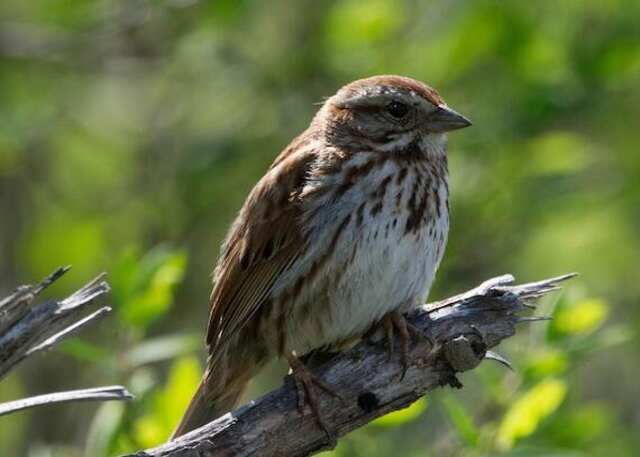
| Attribute | Measurement |
|---|---|
| Length | Approximately 5.5 – 7 inches (14-18 cm) |
| Weight | About 0.6 – 1.1 ounces (17-31 grams) |
| Wingspan | Approximately 7.5 – 9.5 inches (19-24 cm) |
| Diet | Seeds (including niger seeds), insects, small invertebrates |
| Habitat | Grasslands, wetlands, gardens, woodland edges |
| Range | North America, from Alaska to Central America |
- Melodic Minstrel: The Song Sparrow is a small but melodious bird known for its cheerful songs and distinctive markings.
- Habitat: Song Sparrows are commonly found in a wide range of habitats, including grasslands, wetlands, gardens, and woodland edges.
- Dietary Preferences: Their diet primarily consists of seeds, insects, and small invertebrates. They forage on the ground and in low vegetation. While they typically prefer seeds like millet and sunflower, some individuals may occasionally feed on niger (thistle) seeds.
- Distinctive Appearance: Recognizable by their brown streaked plumage with a central dark spot on their breast, surrounded by smaller spots.
- Vocal and Musical: Song Sparrows are known for their varied songs, with each individual having a unique song. Their melodious tunes are a common sound in their habitat.
- Nesting Habits: They often build cup-shaped nests in dense vegetation, using grasses, twigs, and other plant materials.
- Inviting to Bird Feeders: Song Sparrows are occasional visitors to bird feeders, especially when offering a mix of seeds, including millet and niger (thistle) seeds, as well as insects.
- Range: Song Sparrows are native to North America, with a range that extends from Alaska to Central America.
Chipping Sparrow
(Spizella passerina)
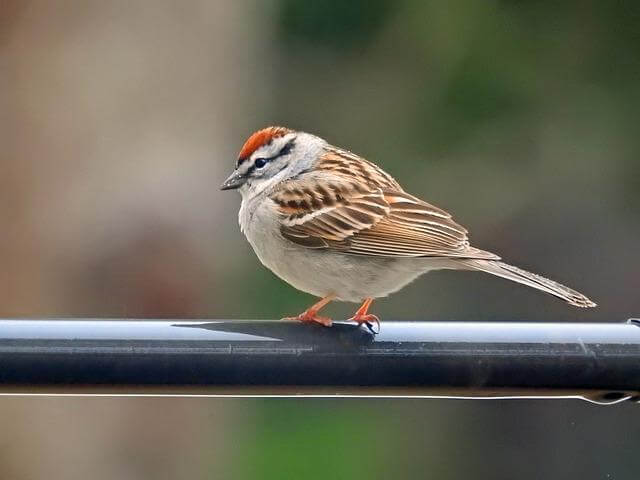
| Attribute | Measurement |
|---|---|
| Length | Approximately 5 – 5.5 inches (13-14 cm) |
| Weight | About 0.4 – 0.6 ounces (11-17 grams) |
| Wingspan | Approximately 7.5 – 8.5 inches (19-22 cm) |
| Diet | Seeds (including niger seeds), insects, small invertebrates |
| Habitat | Gardens, open woodlands, grassy areas |
| Range | North America, with a wide distribution across the continent |
- Tiny Troubadour: The Chipping Sparrow is a small and charming bird known for its distinctive songs and dainty appearance.
- Habitat: Chipping Sparrows are commonly found in various habitats, including gardens, open woodlands, and grassy areas.
- Dietary Preferences: Their diet primarily consists of seeds, insects, and small invertebrates. While they typically favor seeds like sunflower and millet, they may occasionally feed on niger (thistle) seeds when available.
- Distinctive Appearance: Recognizable by their bright chestnut crown, plain grayish body, and a black eyeline that gives them a crisp appearance.
- Vocal and Melodic: Chipping Sparrows are known for their sweet, trilling songs that resemble the sound of a sewing machine.
- Nesting Habits: They often build cup-shaped nests in trees, shrubs, or even on the ground, using grasses and plant fibers.
- Inviting to Bird Feeders: Chipping Sparrows are frequent visitors to bird feeders, where they enjoy a variety of seeds, including sunflower seeds, millet, and occasionally niger (thistle) seeds.
- Range: Chipping Sparrows are native to North America, with a range extending across much of the continent.
White-crowned Sparrow
(Zonotrichia leucophrys)
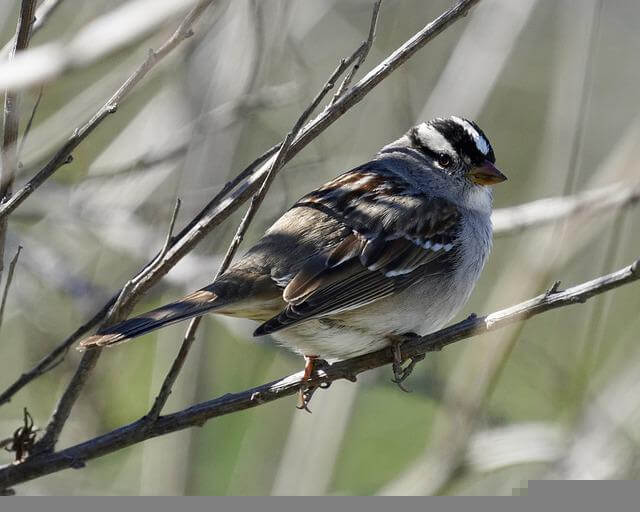
| Attribute | Measurement |
|---|---|
| Length | Approximately 6 – 7 inches (15-18 cm) |
| Weight | About 0.8 – 1.2 ounces (22-34 grams) |
| Wingspan | Approximately 9 – 10 inches (23-25 cm) |
| Diet | Seeds (including niger seeds), insects, small invertebrates |
| Habitat | Shrubby areas, grasslands, woodlands |
| Range | North America, from Alaska to Mexico |
- Crowned Royalty: The White-crowned Sparrow is a regal-looking bird known for its striking appearance and sweet, whistled songs.
- Habitat: White-crowned Sparrows are often found in a variety of habitats, including shrubby areas, grasslands, and woodlands, depending on the season.
- Dietary Preferences: Their diet primarily consists of seeds, insects, and small invertebrates. They have a particular liking for niger (thistle) seeds when available.
- Distinctive Appearance: Recognizable by their bold black and white stripes on their crown, as well as a clean gray face and chestnut wings.
- Vocal and Melodic: White-crowned Sparrows are known for their melodious, whistled songs that vary by region and dialect.
- Nesting Habits: They often build nests in shrubs or low vegetation, creating cup-shaped nests made of grasses and plant materials.
- Inviting to Bird Feeders: White-crowned Sparrows are occasional visitors to bird feeders, where they enjoy a variety of seeds, including niger (thistle) seeds, sunflower seeds, and millet.
- Range: White-crowned Sparrows are native to North America, with a wide range extending from Alaska to Mexico.
Eurasian Siskin
(Spinus spinus)
| Attribute | Measurement |
|---|---|
| Length | Approximately 4.7 – 5.9 inches (12-15 cm) |
| Weight | About 0.4 – 0.6 ounces (12-17 grams) |
| Wingspan | Approximately 7.5 – 9.1 inches (19-23 cm) |
| Diet | Seeds, particularly niger (thistle) seeds, insects |
| Habitat | Coniferous and mixed woodlands |
| Range | Eurasia, from Europe to Asia |
- Petite Gem: The Eurasian Siskin is a small, lively bird known for its vibrant plumage and preference for certain seeds.
- Habitat: Eurasian Siskins are commonly found in coniferous and mixed woodlands across Eurasia.
- Dietary Preferences: Their diet primarily consists of seeds, with a particular fondness for niger (thistle) seeds, which they adeptly extract with their specialized bills.
- Distinctive Appearance: Recognizable by their striking yellow-green plumage with black streaks, males typically have more vibrant colors than females.
- Vocal and Energetic: Eurasian Siskins are known for their lively and twittering calls, especially during the breeding season.
- Nesting Habits: They often build cup-shaped nests in trees, using twigs, grasses, and moss to create cozy nests.
- Inviting to Bird Feeders: Eurasian Siskins are frequent visitors to bird feeders, especially when offering niger (thistle) seeds, sunflower seeds, and other small seeds.
- Range: Eurasian Siskins are native to Eurasia, with a range extending from Europe to Asia.
Black-capped Chickadee
(Poecile atricapillus)

| Attribute | Measurement |
|---|---|
| Length | Approximately 4.5 – 5.5 inches (11-14 cm) |
| Weight | About 0.3 – 0.5 ounces (8-14 grams) |
| Wingspan | Approximately 7 – 8 inches (18-20 cm) |
| Diet | Insects, seeds (including niger seeds), berries |
| Habitat | Woodlands, gardens, suburban areas |
| Range | North America, from Alaska to the northern United States |
- Tiny Charmer: The Black-capped Chickadee is a small, cheerful bird known for its distinctive calls and friendly demeanor.
- Habitat: Black-capped Chickadees are commonly found in a variety of habitats, including woodlands, gardens, and suburban areas.
- Dietary Preferences: Their diet primarily consists of insects, seeds, and berries. They are particularly fond of niger (thistle) seeds, which they crack open with their strong bills.
- Distinctive Appearance: Recognizable by their black cap and bib, white cheeks, and grayish-blue wings and back.
- Vocal and Social: Black-capped Chickadees are known for their signature “chick-a-dee-dee-dee” call and their sociable behavior in mixed-species flocks.
- Nesting Habits: They often build nests in tree cavities or nest boxes, using moss, feathers, and plant materials to create cozy nests.
- Inviting to Bird Feeders: Black-capped Chickadees are frequent visitors to bird feeders, where they enjoy a variety of seeds, especially niger (thistle) seeds, sunflower seeds, and suet.
- Range: Black-capped Chickadees are native to North America, with a range extending from Alaska to the northern United States.
Attracting Birds with Nyjer Seed
Nyjer/Niger (thistle) seed is a popular choice among bird enthusiasts for attracting a variety of seed-loving birds to their yards. To successfully attract birds with Nyjer seed, it’s essential to select the right bird feeders and understand when and how to offer this nutritious seed.
Selecting Bird Feeders for Nyjer Seed
To effectively offer Nyjer seed to birds, choose appropriate bird feeders with small mesh or tiny feeding ports designed to release the seed without spilling. Here are some suitable options:
- Soft Mesh Sock-Style Feeders: These feeders are ideal for Nyjer seed, as they allow birds to cling and feed comfortably while preventing waste.
- Metal Mesh Feeders: Durable metal mesh feeders with small openings are also a good choice, offering durability and longevity.
Timing Matters: Nyjer in Winter
For many birders, offering Nyjer seed in the winter is an excellent option. While seed-eating birds are year-round residents, natural seed supplies can become scarce in winter. Thistle seed feeders are particularly popular during this season, providing essential nutrition for birds during colder months.
Transitioning to Nyjer Seed
If you haven’t offered Nyjer seed before, consider starting with a mixed seed that includes Nyjer. This gradual introduction can help birds become accustomed to the new seed source.
Attracting Birds to Nyjer Seed
Introducing birds to Nyjer seed may require some patience. Here are some tricks to attract birds to a new feeder:
- Place the Feeder Strategically: Position the Nyjer feeder in a visible and accessible location where birds can easily find it.
- Offer Water Nearby: Birds are more likely to visit feeders if a clean water source is available nearby for drinking and bathing.
- Be Consistent: Maintain a regular feeding schedule to establish a reliable food source for visiting birds.
- Patience Pays Off: It may take some time for birds to discover the Nyjer seed feeder. Be patient, and once they find it, they’ll likely become regular visitors.
Bird Feeder Options for Nyjer Seed
Here’s an organized table summarizing bird feeder options for Nyjer seed and the birds they attract:
| Bird Feeder Type | Suitable for Nyjer Seed? | Birds Attracted |
|---|---|---|
| Soft Mesh Sock-Style | Yes | Goldfinches, Siskins, Redpolls, Pine Warblers |
| Metal Mesh Feeders | Yes | Goldfinches, Siskins, Redpolls, House Finches |
| Tube Feeders | Yes | Goldfinches, Siskins, Redpolls, Chickadees |
| Window Feeders | Limited Use | Goldfinches, Siskins, Redpolls, Chickadees |
| Finch Feeders | Yes | Goldfinches, Siskins, Redpolls, House Finches |
| Mesh Tray Feeders | Limited Use | Sparrows, Juncos, Doves, Towhees, Grosbeaks |

